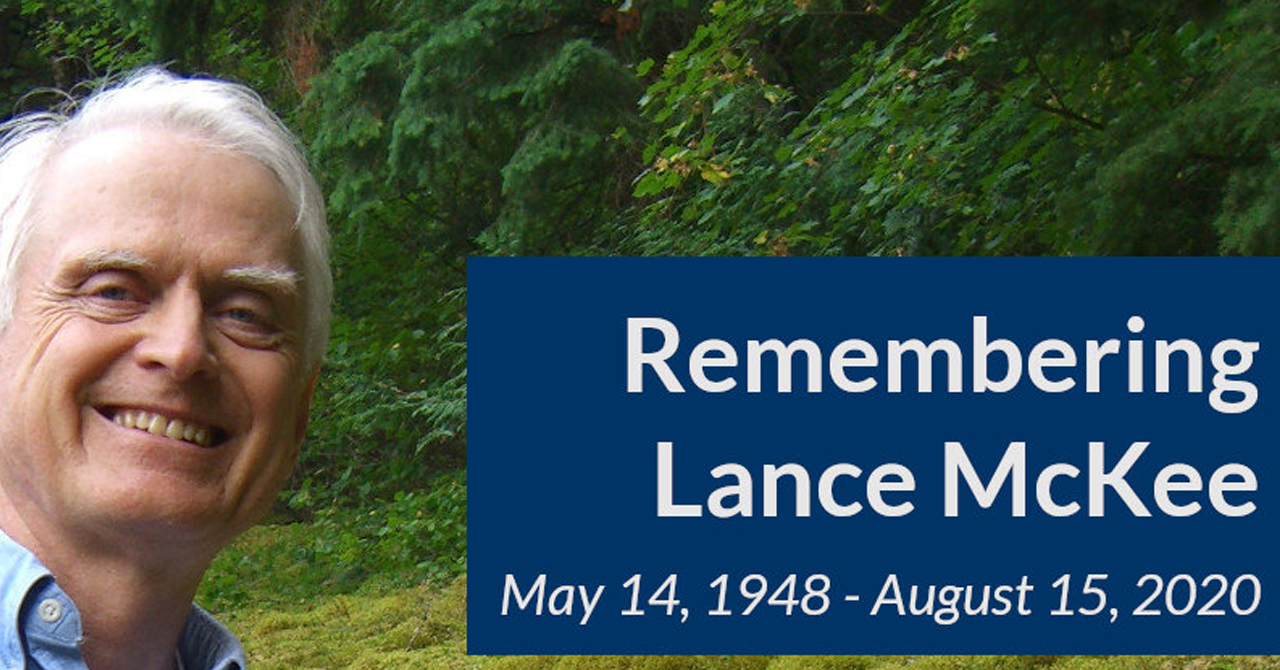The OGC family has lost a cherished friend and impassioned supporter of the use of location information and open standards for good. We recently learned of Lance McKee’s passing from his daughter Caitlin. He died peacefully at the age of 72 from a chronic illness. His intellect, kindness, and compassion for the OGC vision and mission, and the use of location information to improve our society and environment, has left a deep imprint on the OGC and each of us who had the privilege of knowing him.
Lance’s passing is an incredibly sad time of loss for all who had the honor of working with him. We take this opportunity to celebrate his life and contributions to the geospatial community and to the OGC mission.
Our story about Lance begins several years before the formation of what is now the OGC. As co-workers in the mid 1980’s working at MASSCOMP, a Unix-based workstation firm, David Schell and Lance began formulating the concept of the Open Geospatial Consortium, which was fueled initially by their introduction to an early GIS system capability known as GRASS and the implications of this GIS technology to apply what Lance referred to as “earth imaging and analysis” to address key environmental management and geopolitical challenges. The GRASS open source program was used extensively by the U.S. Army Corps of Engineers and other agencies at the time to address environmental and other place-based decision making. As a common platform among agencies, GRASS also enabled geospatial data sharing among organizations.
As a result of Lance’s deep market studies, it did not take long for David and Lance to realize that data sharing among the fast-emerging body of GIS market offerings, each with their own unique data formats, was a major limiting challenge. Together they created a pathway leading to the formation of the Open GIS Consortium in 1994 as a consensus-based industry consortium to advance open, global interoperability standards. The detailed story of OGC’s formation and early growth is fascinating, and a testament to the contributions to the OGC made by Lance. We suggest you review the OGC History written by Lance, then OGC’s VP for Corporate Communications and Senior Staff Writer.
From the organization’s inception in 1994, Lance was the lead voice for OGC in his role as the VP of Corporate Communications. He was deeply involved in the initial design of the OGC, and was instrumental in communicating OGC’s global interoperability mission through his development of key visual representations and narratives regarding OGC technology objectives and processes. Lance was a co-editor and contributor to the first “OpenGIS Guide – Introduction to Interoperable Geoprocessing” along with Kurt Buehler, OGC’s founding CTO. This critically important document delineated the concepts, scope, policies, and processes necessary to drive the Consortium’s development and global adoption of OpenGIS standards. In addition to being the face of OGC in key events worldwide, Lance prepared an astounding array of journal articles, technical reports, and presentations essential to establish OGC as the authoritative global organization dedicated to geospatial interoperability. He possessed an incredible ability to transform complex scientific and technical topics being addressed by the Consortium into understandable and impactful stories of purpose, value, and benefit. Lance continued active involvement with the OGC Community – as OGC staff, as a consultant, and more recently as a member of the Consortium – until just a few years ago.
His thirst to drive solutions to incredibly complex environmental, social, and economic issues continued until his passing – as exemplified in his own words on his LinkedIn Profile:
“In 2016 I retired from my Senior Staff Writer position with the Open Geospatial Consortium (OGC), an organization I helped found and served for 22 years. I’m now working as a free-lance writer. As an OGC member, I co-chair the OGC Electromagnetic Spectrum Domain Working Group (EM Spectrum DWG). I’m interested in writing about how we gauge, predict and manage the social, economic, institutional, political, health and mental impacts of new technologies:
- How can we accelerate research into the biological effects of electromagnetic fields? How might multi-omics bioinformatics efforts feed into cities’ management of cities’ “exposomes”?
- Collaboration among standards development organizations is necessary for progress in environmental accounting, livable cities and science. How can such collaboration become less ad hoc?
- What convergence of technologies, sustainability imperatives and policies will take environmental accounting from an academic exercise to a foundational principle for determining profit and loss?
- How will blockchain technology impact technology application domains in which provenance and metadata are important?
- How can smart cities’ technology providers’ interests best be aligned with citizens’ interests?
- If distributed ownership (e.g. of energy production assets) and local trade are good for urban life and/or sustainability, how can smart city technologies and associated policies support this?
- Our new communication tools are shaping our brains through neural plasticity. Where is this going and where do we want it to go?
- Attention accounting: There’s obviously a difference between an individual’s attention accounting –What’s in my mind now? – and a platform providers’ attention accounting – How can I monetize my machine’s data about what this user is attending to now? Do these relate? How?
I look forward to hearing from people and organizations with similar interests and questions.”
We will deeply miss our colleague and dear friend who was always there to help address a complex technical challenge, to promote the value of open and interdisciplinary science, or to lend an ear and insight on any topic – professional or personal. We will miss this man of incredible intellect, integrity, and passion for making the world a better place for us all.
